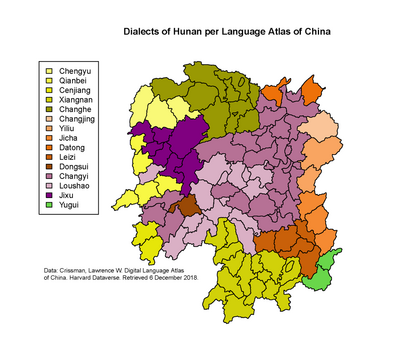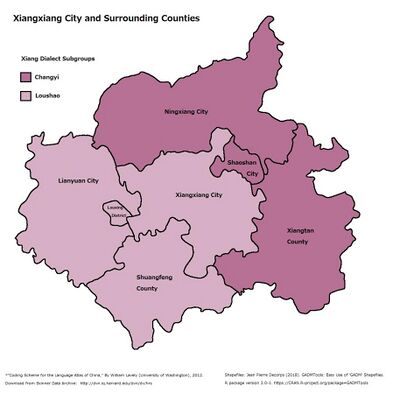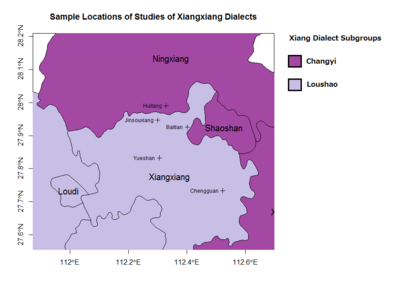Social:Xiangxiang dialect
| Xiangxiang dialect | |
|---|---|
| 湘乡话 | |
| Native to | China |
| Region | Xiangxiang, Hunan province |
Sino-Tibetan
| |
| Language codes | |
| ISO 639-3 | – |
The Xiangxiang dialect (Chinese: 湘乡话; pinyin: Xiāngxiānghuà) is a dialect of Xiang Chinese, spoken in Xiangxiang, Hunan province, China . It is part of a group of dialects called the Central Xiang dialects.[1]
Geographic distribution
The linguistic maps below are derived from the Digital Language Atlas of China,[2] which is derived from the Language Atlas of China,[3] the first atlas to comprehensively catalog and chart the distribution of Chinese dialects.[4] This atlas refers to the two main dialects in Xiangxiang City and its surroundings as Changyi (长益片 / 長益片) and Loushao (娄邵片 / 婁邵片).
The division of Xiang into New Xiang and Old Xiang was introduced by Yuan Jiahua,[5] but has been superseded by the Language Atlas of China classifications.[6]
| Dialect map of Hunan Province according to the Language Atlas of China[2] |
|---|
The Language Atlas of China serves as the starting point for many efforts to further detail, map and classify Xiang dialects, including the many studies of Bao Houxing and Chen Hui.[7][8]
| Dialect map of Hunan Province according to Chen and Bao (2007)[9] |
|---|
| Linguistic map of Xianxiang City and surrounding counties[3] |
|---|
| Sample Locations of Xiangxiang Dialect Studies[1][3][10][11] |
|---|
History and strategic value
The Xiang dialect group forms a transitional zone between northern and southern Chinese dialects.[5]
Prehistorically, the main inhabitants were Ba, Nanman, Baiyue and other tribes whose languages cannot be studied. During the Warring States Period, large numbers of Chu migrated into Hunan. Their language blended with that of the original natives to produce a new dialect Nanchu (Southern Chu). The culture of Xiangxiang at the center of Hunan is considered to be mainly Chu. The language of Shaoshan, Loudi, Shuangfeng and Xiangxiang (Old Xiang) is considered as originating from a synthesis of Chu and the languages of original natives.[12]
Migrations into Hunan can be divided into three periods . Before the Five Dynasties and Ten Kingdoms period, migrants came mainly from the North. Between the Five Dynasties and Ten Kingdoms period and the Ming dynasty, migrants came mainly from Jiangxi. In the early Ming dynasty, large numbers of migrants came from Jiangxi and settled in present day Yueyang, Changsha, Zhuzhou, Xiangtan, and Hengyang districts. Migrants from Jiangxi concentrated mainly in southeastern Hunan and present day Shaoyang and Xinhua districts. They came for two reasons: the first is that Jiangxi became too crowded and its people sought expansion. The second is that Hunan suffered greatly during the Mongol conquest of the Song dynasty, when there was mass slaughter,[1] and needed to replenish its population. After the middle of the Ming dynasty, migration gradually became more diverse and economically and commercially motivated. Migrants who came from the North settled mainly in northern Hunan followed by western Hunan. For this reason northern and western Hunan are Mandarin districts.[12]
Phonology
Comparison with Standard Chinese
| Feature | Standard Chinese | Xiangxiang Locations | Ninxiang Location | ||||
|---|---|---|---|---|---|---|---|
| Dictionary[13] | Chao[14] | Chengguan[1] | Yueshan[11] | Jinsou[10] | Baitian[10] | Huitang[10] | |
| Consonants and Initials |
21 | 23 | 29 | 28 | 24 | 26 | 24 |
| Vowels and Finals |
35 | 37 | 37 | 38 | 42 | 37 | 38 |
| Tones | 4 | 4 | 7 | 5 | 6 | 6 | 6 |
General
These phonetic charts use IPA phonetic symbols with the addition of curly-tail alveolo-palatal symbols[15] and follow the format set forth by Chao.[14]
Consonants
| bilabial | alveolar | denti-alveolar | alveolo-palatal | retroflex | velar | ||
|---|---|---|---|---|---|---|---|
| nasal | m | n | ȵ | ŋ | |||
| plosives | voiced | b | d | ɡ | |||
| voiceless unaspirated | p | t | k | ||||
| voiceless aspirated | pʰ | tʰ | kʰ | ||||
| fricatives | voiced | ɣ | |||||
| voiceless | s | ɕ | ʂ | x | |||
| affricates | voiced | dz | dʑ | dʐ | |||
| voiceless unaspirated | ts | tɕ | tʂ | ||||
| voiceless aspirated | tsʰ | tɕʰ | tʂʰ | ||||
| lateral approximants | l | ||||||
Tones
Phonemically, Xiangxiang dialect has seven tones.[1]
| Tone number | Tone name | Tone contour | Description |
|---|---|---|---|
| 1 | yin ping (陰平) | ˥ (55) | high |
| 2 | yang ping (陽平) | ˩˧ (13) | extra low rising |
| 2' | ci yang ping (次陽平) | ˨˧ (23) | low rising |
| 3 | shang sheng (上聲) | ˨˩ (21) | low |
| 5 | yin qu (陰去) | ˦˥ (45) | high rising |
| 5' | ci yin qu (次陰去) | ˧˥ (35) | high rising |
| 6 | yang qu (陽去) | ˧ (33) | mid |
Jinsou Town[10]
Consonants
| bilabial | alveolar | denti-alveolar | alveolo-palatal | retroflex | velar | Laryngeal | ||
|---|---|---|---|---|---|---|---|---|
| nasal | m | n | ȵ | ŋ | ||||
| plosives | voiced | b | d | ɡ | ||||
| voiceless unaspirated | p | t | k | Ø 油 | ||||
| voiceless aspirated | pʰ | tʰ | kʰ | |||||
| fricatives | voiced | ɣ | ||||||
| voiceless | s | ɕ | ʂ | x | ||||
| affricates | voiced | dz | dʑ | dʐ | ||||
| voiceless unaspirated | ts | tɕ | tʂ | |||||
| voiceless aspirated | tsʰ | tɕʰ | tʂʰ | |||||
| lateral approximants | l | |||||||
Yueshan Town
Tones
| Tone number | Tone name | Tone contour | Description |
|---|---|---|---|
| 1 | yin ping (陰平) | ˥ (55) | high |
| 2 | yang ping (陽平) | ˩˧ (13) | low rising |
| 3 | shang sheng (上聲) | ˨˩ (21) | low |
| 4 | yin qu (陰去) | ˦˥ (45) | high rising |
| 5 | yang qu (陽去) | ˨ (22) | mid |
See also
- Xiang Chinese
- List of Chinese dialects
References
- ↑ 1.0 1.1 1.2 1.3 1.4 1.5 Coblin, W. South (2011). Comparative Phonology of the Central Xiāng Dialects. Taipei, Taiwan: Institute of Linguistics, Academia Sinica. ISBN 978-986-02-9803-1.
- ↑ 2.0 2.1 Crissman, Lawrence W. (23 November 2012). "Digital Language Atlas of China". doi:10.7910/DVN/OHYYXH. https://hdl.handle.net/1902.1/18939.
- ↑ 3.0 3.1 3.2 Lavely, William; Berman, Lex (18 October 2012). "Language Atlas of China". doi:10.7910/DVN/QPUONU. https://hdl.handle.net/1902.1/19004.
- ↑ Cao, Zhiyun; Liu, Xiaohai (14 December 2012). "The Introduction of Linguistic Atlas of Chinese Dialects". Papers from the First International Conference on Asian Geolinguistics: 141–151. https://drive.google.com/file/d/0BzeLRjfEMUL-RXN4UUIzT1dOcEU/view. Retrieved 7 December 2018.
- ↑ 5.0 5.1 Wu, Yunji (2011). A Synchronic and Diachronic Study of the Grammar of the Chinese Xiang Dialects. Berlin: De Gruyter Mouton. ISBN 978-3-11-018366-5. https://books.google.com/books?id=YYwhPW7ErvcC&q=Bao+houxing&pg=PA415.
- ↑ Kurpaska, Maria (2010). Chinese Languages: A Look Through the Prism of the Great Dictionary of Modern Chinese Dialects. Berlin: De Gruyter Mouton. ISBN 978-3-11-021914-2. https://books.google.com/books?id=lCgnrA7Ke3QC.
- ↑ Bao, Houxing 鲍厚星; Chen, Hui 陈晖 (2005). "Xiāngyǔ de fēnqū (gǎo)" (in zh). Fāngyán 2005 (3): 261–270.
- ↑ Li, Kang-cheng 李康澄 (2014). "Jìn 30 nián Húnán Hànyǔ fāngyán bǐjiào yánjiū shùpíng" (in zh). Húnán Kējì Dàxué xuébào (shèhuì kēxué bǎn) 17 (4): 136–143. doi:10.13582/j.cnki.1672-7835.2014.04.022. http://hnkjsk.cnjournals.com/ch/reader/create_pdf.aspx?file_no=20140422&flag=1&journal_id=hnkjdxxbsk&year_id=2014.
- ↑ Chen, Hui 陈晖; Bao, Houxing 鲍厚星 (2007). "Húnán Shěng de Hànyǔ fāngyán (gǎo)" (in zh). Fāngyán 2007 (3): 250–259. http://www.cqvip.com/qk/81953x/200703/25428043.html.
- ↑ 10.0 10.1 10.2 10.3 10.4 Wen, Dan 文丹 (2004) (in zh). Húnán Níngxiāng yǔ Xiāngxiāng biānjiè dōng duàn de fāngyán zhuàngkuàng. Changsha, China: Hunan Normal University. http://cdmd.cnki.com.cn/Article/CDMD-10542-2004090179.htm. Retrieved 27 November 2018.
- ↑ 11.0 11.1 11.2 Nakajima, Motoki 中嶋 幹起 (1990) (in ja). Shōhōgen chōsa hōkoku-ka saku. Tōkyō: Tōkyō Gaikokugo Daigaku Ajia Afurika Gengo Bunka Kenkyūjo. ISBN 4-87297-025-X.
- ↑ 12.0 12.1 Jiang, Junfeng (2006). A Phonological Study of Xiangxiang Dialect (PhD thesis). Hunan Normal University.
- ↑ (in zh) Xiàndài Hànyǔ cídiǎn (6th ed.). Beijing: Shangwu yinshuguan. 2012. ISBN 978-7-100-08467-3.
- ↑ 14.0 14.1 Chao, Yuen Ren (1968). A Grammar of Spoken Chinese. Berkeley: University of California Press. ISBN 0-520-00219-9. https://archive.org/details/grammarofspokenc0000chao.
- ↑ Cook, Richard S. Jr. (2000). "On the Status of the Curly-Tail Alveolo-Palatal (舌面前) Symbols [ȶ, ȡ, ȴ, ȵ, ɕ, ʑ"]. http://stedt.berkeley.edu/pdf/curly-tailed-tdnlcz.pdf.
Bibliography
- Hunan Sheng difangzhi bianzuan weiyuanhui 湖南省地方志编纂委员会 (2001) (in zh). Húnán shěngzhì, dì-èrshíwǔ juǎn, fāngyán zhì, shàngcè. Changsha: Hunan renmin chubanshe. http://218.76.24.115/BookRead.aspx?bookid=201604080046.
- Li, Jialong 李加龙 (2017) (in zh). Hànyǔ fāngyán diàochá. Beijing: Shangwu yinshuguan. ISBN 978-7-100-12869-8.
- "Húnán fāngyán zhōng tā zuì nán dǒng bèi chēng wèi "Húnán de wàiguóhuà"" (in zh). Xiāoxiāng chénbào. 3 April 2017. http://view.inews.qq.com/a/HNN2017040301429506.
Categories
 |





